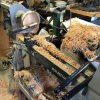I've been given a Shop Fox w1758 by a friend. It was unfortunately dropped on the spindle at some point. The end of the spindle is bent in and it is slightly bent overall.
I've been able to use the lathe by doing small faceplate mounted turnings with a waste block. I also bolted a piece of wood to the faceplate and sanded it with the axis and that took most of the wobble out of the rough workpiece.
I have a spindle coming on backorder from the shop fox company, I assume being machined in china considering the suprising rather low cost of it. Has anyone changed a spindle in one of these or a similar lathe? Will I need any special tools or anything important I need to know? I haven't torn it apart yet to see how it's together.
It is also variable speed, it's supposed to be 600-3000, mine on low is about 850rpm. I've seen that it may be a worn belt that is bringing up the speed. Before I order a new belt, if I were to find a smaller pulley for the motor and a belt that was the right size for that setup, could it bring the overall speed of the lathe down lower? Would it hurt the motor or anything?
Thanks a lot.
I've been able to use the lathe by doing small faceplate mounted turnings with a waste block. I also bolted a piece of wood to the faceplate and sanded it with the axis and that took most of the wobble out of the rough workpiece.
I have a spindle coming on backorder from the shop fox company, I assume being machined in china considering the suprising rather low cost of it. Has anyone changed a spindle in one of these or a similar lathe? Will I need any special tools or anything important I need to know? I haven't torn it apart yet to see how it's together.
It is also variable speed, it's supposed to be 600-3000, mine on low is about 850rpm. I've seen that it may be a worn belt that is bringing up the speed. Before I order a new belt, if I were to find a smaller pulley for the motor and a belt that was the right size for that setup, could it bring the overall speed of the lathe down lower? Would it hurt the motor or anything?
Thanks a lot.

